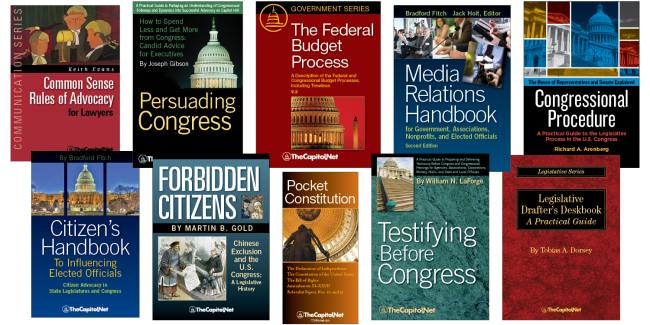From the Congressional Glossary – Including Legislative and Budget Terms
Appropriation Act / Appropriation Bill / Continuing Resolution / Continuing Appropriations

Appropriation Act: A statute, under the jurisdiction of the House and Senate Committees on Appropriations, that generally provides legal authority for federal agencies to incur obligations and to make payments out of the Treasury for specified purposes. An appropriation act fulfills the requirement of Article I, Section 9, of the U.S. Constitution, which provides that “no money shall be drawn from the Treasury, but in Consequence of Appropriations made by Law.” Under the rules of both houses, an appropriation act should follow enactment of authorizing legislation.
Major types of appropriation acts are regular, supplemental, deficiency, and continuing. Regular appropriation acts are all appropriation acts that are not supplemental, deficiency, or continuing. Currently, regular annual appropriation acts that provide funding for the continued operation of federal departments, agencies, and various government activities are considered by Congress annually. From time to time, supplemental appropriation acts are also enacted. When action on regular appropriation bills is not completed before the beginning of the fiscal year, a continuing resolution (often referred to simply as “CR”) may be enacted in a bill or joint resolution to provide funding for the affected agencies for the full year, up to a specified date, or until their regular appropriations are enacted. A deficiency appropriation act provides budget authority to cover obligations incurred in excess of available budget authority.
See also:
NASA Proposed FY 13 Budget, House Appropriations Committee Hearing, March 21, 2012
By congressional custom, an appropriations bill originates in the House, and it is not supposed to be considered by the full House or Senate until a related measure authorizing the funding is enacted. The latter restriction is often ignored, however. An appropriation bill grants the actual money approved by authorization bills, but not necessarily the full amount permissible under the authorization. The 1985 Gramm-Rudman-Hollings law stipulated that the House pass by June 30 the last regular appropriations bill for the fiscal year starting October 1. (There is no such deadline for the Senate.) However, appropriations often have not been completed until well after the fiscal year begins, requiring a succession of stopgap bills to continue the government’s functions. In addition, much federal spending – about half of all budget authority, notably that for Social Security and interest on the federal debt – does not require annual appropriations; those programs exist under permanent appropriations.
Continuing Resolution / Continuing Appropriations: Legislation in the form of a joint resolution enacted by Congress, when the new fiscal year is about to begin or has begun, to provide budget authority for Federal agencies and programs to continue in operation until the regular appropriations acts are enacted.
The “Status of Appropriations Legislation” can be found on Congress.gov.
David Hawkings’ Whiteboard: Continuing Resolutions
From Congressional Procedure, Ch. 7.A.:
The budget is like a personal budget—your plan for how much money you expect to be earning, how much money you will spend and how you will spend it.
Authorizations may be thought of as decisions you might make that impact your budget, such as signing an apartment lease, buying an automobile, purchasing a home, or even having a child.
Appropriations are like payments you actually make under your budget, like paying the rent, utility bills, or buying groceries. You might have budgeted $300 for groceries, but ended up spending $350. Your appropriation is $350.
If you spend more than you bring in, you must borrow the difference. If you spend less, you have a surplus and may be able to invest it or save for a child’s education.
Also see
- Appropriation / Cardinals of Congress (CongressionalGlossary.com)
- Authorization (CongressionalGlossary.com)
- Budget Authority (CongressionalGlossary.com)
- By Request (CongressionalGlossary.com)
- Clean Bill (CongressionalGlossary.com)
- Omnibus Bill (CongressionalGlossary.com)
- Report / Reported (CongressionalGlossary.com)
- § 7.80 Authorizations and Appropriations Processes, § 8.50 Congress and the Executive: Appropriations, § 8.160 Congress and Foreign Policy: Legislation, Appropriations, and Nominations, in Congressional Deskbook
- Chapter 1.B. Constitutional Provisions; Chapter 2.N. Regular Order; Chapter 3.B. Committees and Subcommittees; Chapter 7.G. Authorizations; Chapter 7.H. Appropriations; Chapter 7.J. Debt Ceiling; Chapter 7.K. Earmarks; in Congressional Procedure
Fiscal Law #1 – Overview
More
- House Committee On Appropriations
- Senate Committee on Appropriations
- Senate Committee on Appropriations, Appropriations Bills
- “The Congressional Appropriations Process: An Introduction,” CRS Report 97-684 (30-page PDF
 )
) - “The Congressional Appropriations Process: An Introduction,” CRS Report R42388 (28-page PDF
 )
) - “Authorizations and the Appropriations Process,” CRS Report R46497 (17-page PDF
 )
) - “Overview of the Authorizations and the Appropriations Process,” CRS Report RS20371 (5-page PDF
 )
) - “The Appropriations Process: A Brief Overview,” CRS Report R47106 (18-page PDF
 )
) - “Authorization of Appropriations: Procedural and Legal Issues,” CRS Report R42098 (18-page PDF
 )
) - “Advance Appropriations, Forward Funding, and Advance Funding,” CRS Report RS20441 (5-page PDF
 )
) - “Supplemental Appropriations,” CRS Report RL33134 (13-page PDF
 )
) - “The Appropriations Process and the Congressional Budget Act,” CRS Report 97-947 (12-page PDF
 )
) - “Appropriations Subcommittee Structure: History of Changes from 1920-2023,” CRS Report RL31572 (19-page PDF
 )
) - “Examples of Legislative Provisions in Annual Appropriations Acts,” CRS Report RL30619 (25-page PDF
 )
) - “Overview of Continuing Appropriations for FY2021 (P.L. 116-159),” CRS Report R46582 (33-page PDF
 )
) - “Continuing Resolutions: Overview of Components and Practices,” CRS Report R46595 (36-page PDF
 )
) - “Budget Process and Enforcement,” Parliamentary Boot Camp (4-page PDF
 )
) - Principles of Federal Appropriations Law, GAO’s Red Book – GAO
- “Congress’ Continuing Resolution Is an Opportunity for Reform,” by Veronique de Rugy
Courses
- Congressional Operations Briefing – Capitol Hill Workshop
- Drafting Federal Legislation and Amendments
- Writing for Government and Business: Critical Thinking and Writing
- Custom Training
- Congressional Operations Poster, with Federal Budget Process Flowchart
- Federal Budgeting, a Five-Course series on CD
- Congress, the Legislative Process, and the Fundamentals of Lawmaking Series, a Nine-Course series on CD
Publications
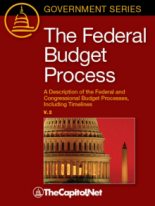
The Federal Budget Process 2E |
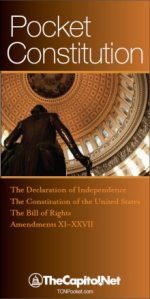
Pocket Constitution |
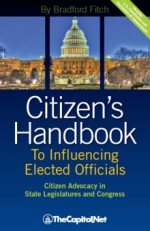
Citizen’s Handbook to Influencing Elected Officials: A Guide for Citizen Lobbyists and Grassroots Advocates |
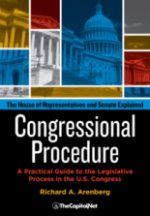
Congressional Procedure |
CongressionalGlossary.com, from TheCapitol.Net
For more than 40 years, TheCapitol.Net and its predecessor, Congressional Quarterly Executive Conferences, have been teaching professionals from government, military, business, and NGOs about the dynamics and operations of the legislative and executive branches and how to work with them.
Our custom on-site and online training, publications, and audio courses include congressional operations, legislative and budget process, communication and advocacy, media and public relations, testifying before Congress, research skills, legislative drafting, critical thinking and writing, and more.
TheCapitol.Net is on the GSA Schedule, MAS, for custom on-site and online training. GSA Contract GS02F0192X
TheCapitol.Net is now owned by the Sunwater Institute.
Teaching how Washington and Congress work ™

